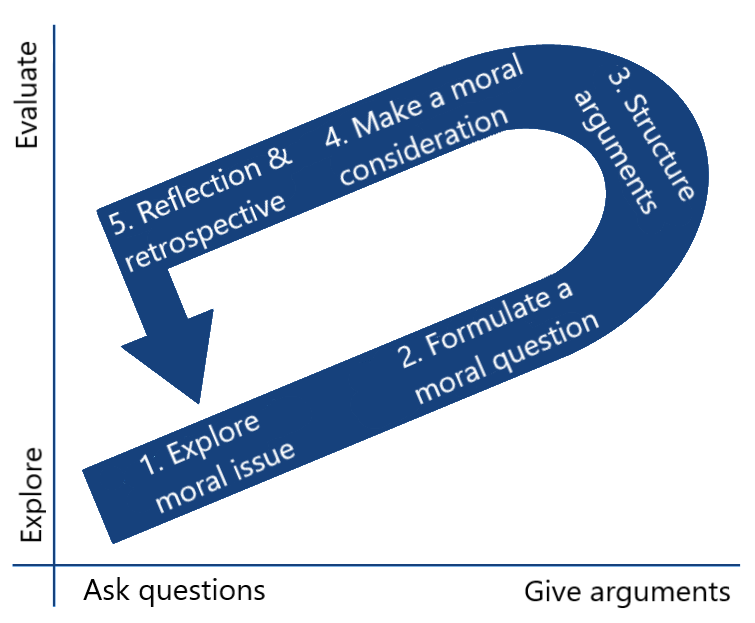
Starting a Moral Case Deliberation with Drawing
Successfully initiating and concluding a moral case deliberation requires a structured approach. This ensures that the ethical question is answered and that everyone is willing to implement the ethical judgment. The structure of the ethical deliberation ensures that all perspectives are considered, making the process of resolving an ethical dilemma more organized and expedient.
Weighing ethical judgments based on moral arguments transforms a discussion driven by emotions into a dialogue aimed at improving ethical judgment. It also facilitates alignment of ethical judgments and moral compasses among participants.
What does a moral case deliberation look like?
In a moral case deliberation, the participants examine a specific moral issue, such as a work-related situation involving one of them. They follow a structured process and are guided by a facilitator. A moral deliberation is meaningful when it meets the following conditions:
- Moral considerations are context-dependent, which is why a concrete issue is the focal point in a ethical deliberation / moral deliberation
- A moral judgment pertains to what constitutes ‘good coexistence,’ whereas a moral issue transcends the individual
- You enhance the moral-/ ethical deliberation with new arguments, a step-by-step plan, and the assistance of a process facilitator
The rules of initiating a moral case deliberation
Just like in any meeting, clear structure is important when starting and concluding a moral deliberation. The facilitator explains to the participants why they are there (purpose), how the process will unfold (steps), and what is expected of them (ground rules). Before delving into the moral issue and the steps of the process, it’s important to take a moment to review the ground rules. Moral deliberations often involve topics that evoke emotions in some participants and/or subjects that have never been discussed among the attendees before. The ground rules are designed to ensure that everyone feels safe to share arguments freely. They encompass process agreements about asking questions, presenting arguments (or refraining from doing so), minimizing the expression of emotions, and what to do if this becomes challenging, among other aspects.

The moral issue / ethical issue (step 1)
One of the participants introduces a (previously selected) concrete moral issue / ethical issue. A specific case or scenario. The first step is to explore this case together. This is done by asking clarifying questions. These questions are aimed at obtaining a concrete and complete picture of the situation. They are ‘who’, ‘what’, ‘when’, ‘how much’, etc. questions. At the end of this step, everyone has the ‘scene’ in their minds and can potentially even draw it out. Let those who want to draw, do so as well.
The presenter of the case can also start by drawing it out (a so-called rich picture). Afterward, other participants can ask their clarifying questions. For instance, ‘who is there,’ ‘what is that person doing there,’ etc. Using visual techniques is a valuable addition, especially to get less obvious questions. This helps to gain (even) more context. And since a ethical deliberation is context-bound, the more context, the better.
Formulating the Moral Question (Step 2)
Once the case is fully understood, you formulate the moral question together. This is the question you want to have answered at the end of the moral deliberation. The conditions that a moral question must meet are:
- The moral question clarifies who is involved (and in what role).
- The moral question formulation indicates which action the question is about.
- The presented moral dilemma is thought-provoking
- The wording in the moral question is neutral
Points 1 and 2 are about ‘who does what’. Point 3 adds why it is a moral issue. Point 3 also indicates where the case touches upon ‘good coexistence’. Therefore, it’s important to pay attention to also fulfill point 4.
In point 3, you firmly establish why discussing this topic is necessary for ‘good coexistence’. You provoke the participants and indicate its importance. It’s tempting to use strong words for this purpose. However, using strong words can backfire if they steer the outcome of the discussion. If you label something as ‘bad’, ‘unacceptable’, or even ‘unfair’ right from the start, you’re already expressing a judgment in the question, even though the discussion has just begun!
What does a good moral question look like? Here are a few examples:
Below are a few examples of moral questions. The points (1, 2, and 3) are indicated next to the respective parts of the question:
- Is it acceptable for a welfare recipient (1) to personally care for their children (2), resulting in fewer available hours for paid work and consequently the government continuing to provide the welfare assistance, at least in part, for an extended period (3)? Pay attention to the neutral word choices, such as ‘welfare recipient’ instead of ‘unemployed person’ and ‘the government’ instead of ‘taxpayer’.
- Is it desirable for Meta (parent company of Instagram) (1) to employ techniques to show users more relevant content (2), without taking into consideration potential risks to the mental health of some users? I intentionally use the term ‘techniques’ as ‘algorithms’ has gained negative connotations recently. Additionally, I refer to ‘showing users more relevant content’ instead of ‘keeping them on the platform longer’ (4).
These are two examples. In a moral deliberation, you collectively determine the question and thus the choice of words. As a group, you can make different choices than those mentioned above. The most important thing is to be constantly aware of the significant influence that words in the question have on the outcome of the deliberation.
Structuring the moral arguments (Step 3)
A structured approach to the moral deliberation and moral evaluation contributes to finding perspectives. A fixed range of focal points prevents overlooking aspects and serves as the framework upon which the decision-making process can be hung.
Moral deliberations have been around for a long time. Utilizing the structures and focal points developed over the years saves time and enhances the quality of your moral evaluation. These frameworks have been extensively tested and adjusted as needed. In the following structure, participants present their arguments for each focal point:
- Which values and norms are relevant here?
- What virtues (character traits) do you see?
- What types of responsibilities are at play?
- Which freedoms and rights are at stake?
- Is the treatment, distribution, and procedure just?
Structuring the moral consideration (step 4)

The final step is to form a collective moral judgment. Different perspectives have been shared, and arguments within each area of focus in the case have been exchanged. The question now is: which arguments are the most important to us? Ideally, the steps and discussions in the preceding stages have already led to increased understanding of each other’s arguments and perspectives. The moral judgments have already been somewhat aligned. Based on that foundation, you collectively determine how to prioritize and ultimately cluster the arguments. Some possible ways to prioritize include:
- Engage in a dialogue per area of focus regarding the order of arguments.
- Each participant allocates a limited number of points to the arguments. The ones with the most points are retained (dotmocracy / dot-voting).
- In a larger forum (with many participants), they can be divided into groups and asked to identify a specific number of arguments within each group that should be retained.
- Optionally, dotmocracy / dot-voting can be applied within those groups again
Next, you cluster the remaining arguments into an answer to the question. The identified arguments form the focal points that must be addressed in the answer. As a result, the answer to a moral question typically follows the structure of yes, provided that… or no, unless…
The chosen arguments would fill in the gaps. For example, considering the earlier posed moral question about the care for children by someone on social assistance, if significant arguments were presented such as employed individuals arrange childcare and work should be incentivized, the answer would be structured as follows:
No, unless the offered job results in out-of-school childcare costs exceeding the additional income.
Reflection on the moral judgment and the deliberation process (Step 5)
First, you look back at the content. The moral judgment has been formed. How do you feel about it now? Are you going to implement the decision? Throughout the process, we have placed feelings in the background to remain as open as possible to each other’s arguments and perspectives. However, this does not mean that emotions do not play a role.
Unconsciously, you are capable of perceiving much more than consciously. If you still feel uncomfortable or unsure about all the conscious considerations, it may indicate that you have missed something or overlooked something too easily. Don’t conclude the deliberation until everyone’s feelings are in alignment.
And remember: this is an opportunity to improve as a team in moral deliberation. In the retrospective, you look for ways to enhance the process together. In professions like the police, fire department, and various other high-risk jobs, they conduct an After Action Review after an operation. In this review, they go through the following questions together:
- What was the intended outcome?
- What is the achieved outcome?
- How did we arrive at that outcome?
- What will we do again next time?
- What will we no longer do?
There are various examples and variations of an After Action Review available on the internet.
Initiating and Concluding a Moral Case Deliberation on Time
There is no standard duration for a moral deliberation. The whiteboard with post-its in the photo represents the outcome of a 2.5-hour moral deliberation. Going through the steps over multiple sessions is also possible, for example, allocating 2 hours for each step. The optimal approach depends on factors such as group size, complexity (and available information) of the case, number of participants, their availability, etc. While taking sufficient time for a moral deliberation is important, too much time can have counterproductive effects.
It is important to timebox the phases and components within a deliberation. This means clearly indicating beforehand how much time is available for each aspect and adhering to that schedule. One reason is that participants often have busy schedules. If the session runs over time, people may leave prematurely or mentally shift their focus to their next activity. A well-defined time plan also helps maintain focus.
A ethical deliberation is well-suited for in-depth discussions and exploring various tangents. A strict time schedule, with regular reminders from the facilitator, encourages participants to remain focused on the issue at hand and the arguments directly related to it. The key to successfully initiating and concluding a moral case deliberation on time is, as they say, in initiating to conclude on time.
Nick Nijhuis helps organizations become digitally mature, serves as a business innovation lecturer, conducts training in moral leadership, and serves as a NIMA examiner.

